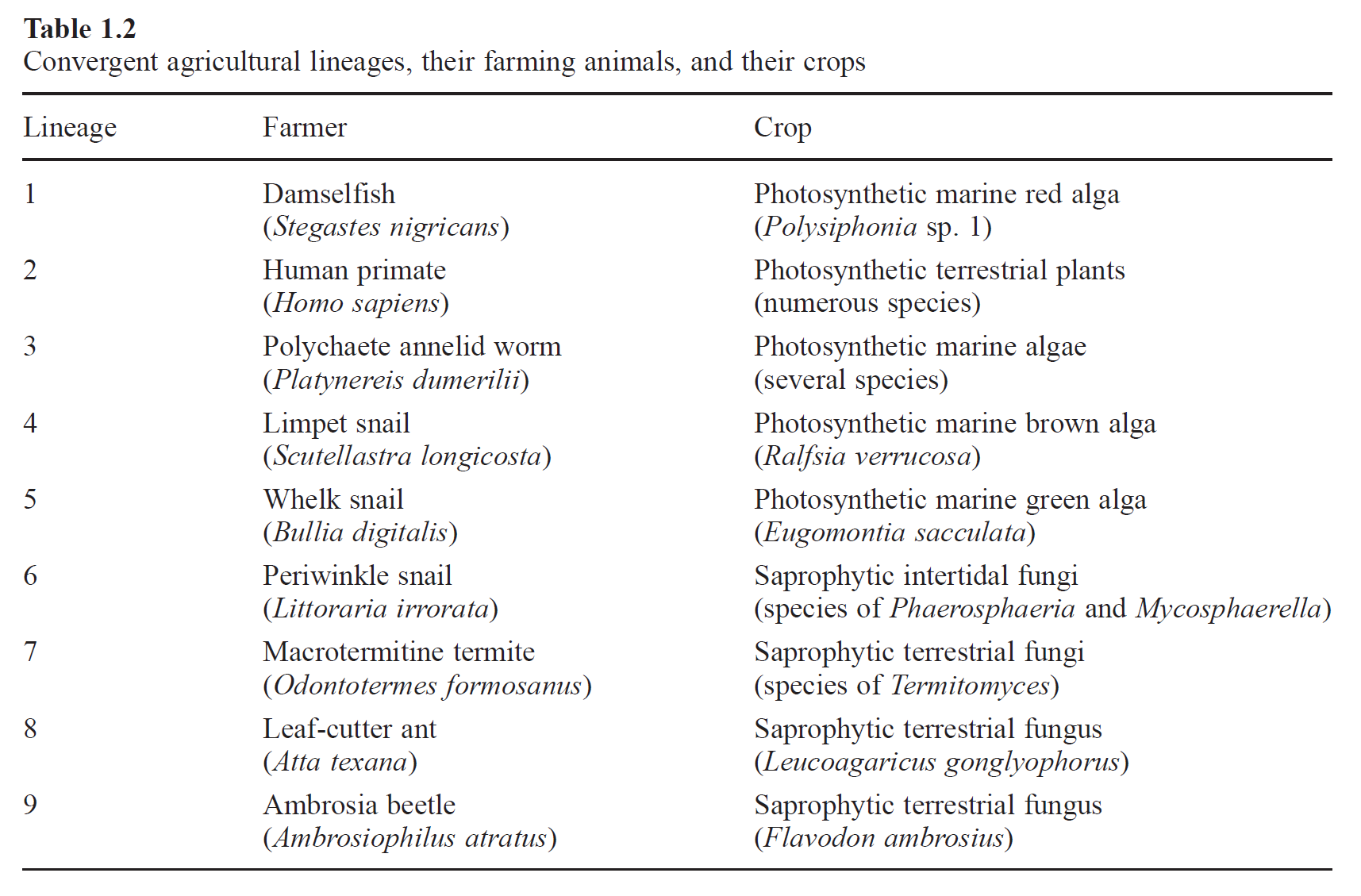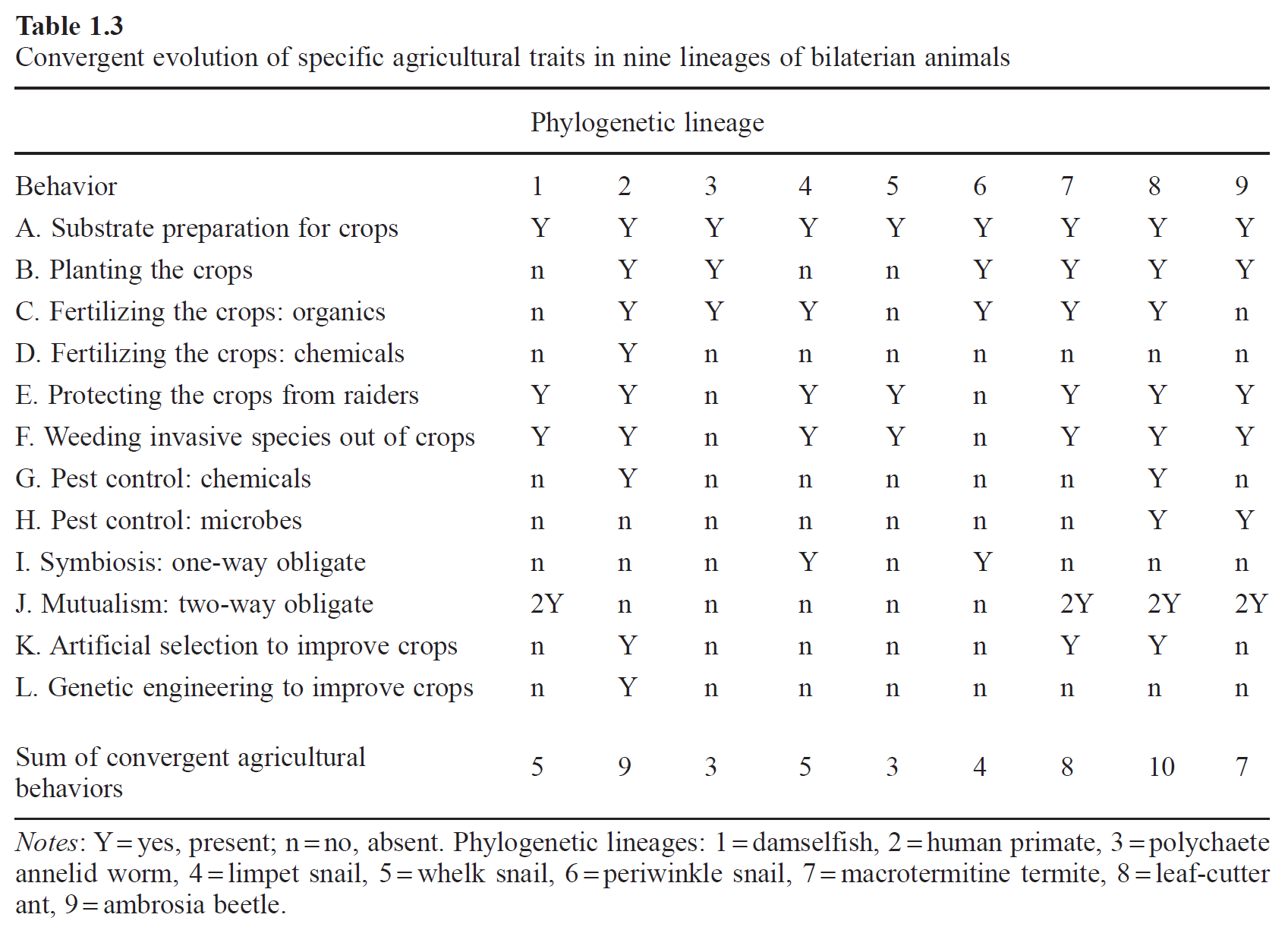Agriculture
This note is about agriculture (or farming), especially as practiced by nonhuman species.
Ants can cultivate:
- plants or fungi (gardening), some 248 species of ants cultivate fungi; individuals can specialise, e.g., gathering raw materials (e.g., leaves), “weeding” crops, or harvesting
- herds for milking
- herds for meat
Hanisch, Priscila Elena, Jeffrey Sosa-Calvo, and Ted R Schultz. ‘The Last Piece of the Puzzle? Phylogenetic Position and Natural History of the Monotypic Fungus-Farming Ant Genus Paramycetophylax (Formicidae: Attini)’. Insect Systematics and Diversity 6, no. 1 (2022): 11. https://doi.org/10/gtbqr8.
During the past 65 million years, agriculture originated a minimum of 20 times in nonhuman animals, including at least 15 times in insects (ants, termites and beetles).
Ješovnik, Ana, and Ted R. Schultz. ‘Agricultural and Proto-Agricultural Symbioses in Ants’. In The Convergent Evolution of Agriculture in Humans and Insects, edited by Ted R. Schultz, Richard Gawne, and Peter N. Peregrine, 143–59. Cambridge, MA: MIT Press, 2022.
Definitions
cultivation: Targeted intervention in the life cycle of a particular species in order to promote its growth, including practices such as tillage, planting, and harvesting.
domestication: Genetic modification of one species (the domesticate) by another (the farmer) in ways that benefit the farmer but that would reduce the fitness of the domesticate in its original niche.
agriculture: Cultivation on a large scale in which the farmer has become obligately dependent on the cultivated species for nutrition.
From the Introduction here: Ješovnik, Ana, and Ted R. Schultz. The Convergent Evolution of Agriculture in Humans and Insects. Edited by Ted R. Schultz, Richard Gawne, and Peter N. Peregrine. Cambridge, MA: MIT Press, 2022.
Within this, it is common to call ants farmers and emphasize that they can suffer from the same challenges as human farmers, e.g., pests.


Ješovnik, Ana, and Ted R. Schultz. ‘Convergent Evolution of Agriculture in Bilaterian Animals: An Adaptive Landscape Perspective’. In The Convergent Evolution of Agriculture in Humans and Insects, edited by Ted R. Schultz, Richard Gawne, and Peter N. Peregrine, 8–30. Cambridge, MA: MIT Press, 2022.
Notes
Can owls or other animals 'farm'? They can prepare and exercise control over their environments. Perhaps not extending to the definitions above that require stronger and mass participation. Might another term be more appropriate? For example, Australian Indigenous practices of 'care' for Country are similarly distinct from industrial or top-down agriculture.
Traditional practices such as 'firestick agriculture' or 'terra preta' come to mind.
Firestick farming is a variation of a foraging strategy and it is easier to accept that powerful owls, for example, do foraging because defining animal behaviour as foraging is common.
Bliege Bird, Rebecca, Douglas W. Bird, Brian F. Codding, Charles H. Parker, and James H. Jones. ‘The “Fire Stick Farming” Hypothesis: Australian Aboriginal Foraging Strategies, Biodiversity, and Anthropogenic Fire Mosaics’. Proceedings of the National Academy of Sciences 105, no. 39 (2008): 14796–801. https://doi.org/10/cqvkm5.
Cf. 'foraging theory'
E.g., carnivores can forage for prey but are also likely foraging for nutrients. Similarly, they might be doing it for the future, for their young, etc.
Kohl, Kevin D., Sean C. P. Coogan, and David Raubenheimer. ‘Do Wild Carnivores Forage for Prey or for Nutrients?’ BioEssays 37, no. 6 (2015): 701–9. https://doi.org/10/f26h6f.
Foraging here means feeding behaviour.
The influential book that introduced the study of foraging behaviour through optimality modelling (trying to show which traits lead to adaptive success).
Aims to explain such phenomena as 'wasteful killing' or 'partial consumption of prey' as results of 'economic considerations'.
Stephens, David W., and John R. Krebs. Foraging Theory. Princeton: Princeton University Press, 1986.
For a brief 'primer' on foraging, see:
King, Andrew J., and Harry H. Marshall. ‘Optimal Foraging’. Current Biology 32, no. 12 (2022): R680–83. https://doi.org/10/gqzzth.
Compare this with the observation on the consumption of food (carcasses) by ravens who feed with wolves (or human hunters) immediately after the kill but leave the other carcasses untouched. The explanation offered is that this is how they evolved to cooperate across species.
Heinrich, Bernd. Mind of the Raven: Investigations and Adventures with Wolf-Birds. New York: Harper Perennial, 2006.
In Traditional Practices
Budj Bim Cultural Landscape, an application to nominate aquaculture as 'cultural landscape'.